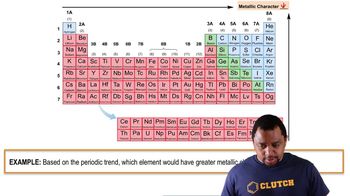Here are the essential concepts you must grasp in order to answer the question correctly.
Ionic Character
Ionic character refers to the degree to which a bond between two atoms exhibits ionic properties, as opposed to covalent properties. It is influenced by the difference in electronegativity between the two atoms involved in the bond. A higher ionic character indicates a greater transfer of electrons from one atom to another, resulting in the formation of charged ions.
Recommended video:
Metallic Character Example
Electronegativity Difference
Electronegativity is a measure of an atom's ability to attract and hold onto electrons in a chemical bond. The electronegativity difference between two bonded atoms can help predict the bond type: a small difference typically indicates a covalent bond, while a large difference suggests an ionic bond. The graph in the question illustrates how this difference correlates with the percent ionic character of various compounds.
Recommended video:
Percent Ionic Character Graph
The percent ionic character graph plots the electronegativity difference against the percent ionic character for various compounds. This visual representation allows for the estimation of ionic character based on electronegativity differences. By analyzing the position of HBr on this graph, one can estimate its ionic character relative to other compounds, providing insight into the nature of the H-Br bond.
Recommended video:
Metallic Character Example

 Verified step by step guidance
Verified step by step guidance


